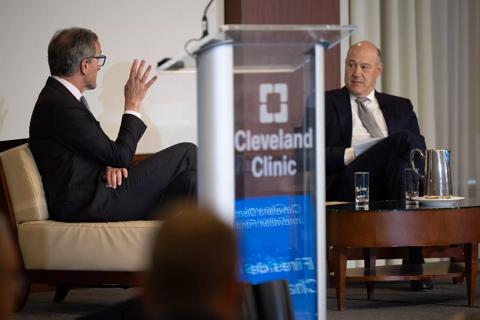Advertisement
Addition and renovation will improve patient access and experience

On May 20, 1997, Cleveland Clinic broke ground on the existing Cole Eye building. Exactly 25 years to the day, on May 20, 2022, it broke ground on the next iteration — a 150,000-square-foot addition (see concept rendering, above) and a renovation of the original 130,000-square-foot building.
Advertisement
Cleveland Clinic is a non-profit academic medical center. Advertising on our site helps support our mission. We do not endorse non-Cleveland Clinic products or services. Policy
During that quarter-century, Cleveland Clinic Cole Eye Institute’s volumes grew exponentially. Patient visits increased from 130,000 in 2008 to more than 330,000 annually — now among the highest volumes in the U.S. Over the same period, surgical procedures increased from 5,000 to more than 18,000 per year. The institute grew from 35 staff physicians and researchers in 2008 to more than 140 today.
But sheer growth is not the only factor driving the expansion. Patient care has changed in the past 25 years and so have clinical innovations, research advances and educational opportunities. The reconstruction of the Cole Eye Institute’s flagship location incorporates all of these changes and represents a new approach to eye care, says Daniel F. Martin, MD, Chairman of the Cole Eye Institute.
“The renovation and the new Jeffrey and Patricia Cole Building are intended to improve access for patients, increase capabilities and enhance patient experience,” he says.
Design plans have been in development for years, incorporating insights from a cross section of Cole Eye Institute patients and caregivers. Working groups of clinical, education and research personnel have met regularly with architects to discuss how to optimally design the new spaces, which will include:
“These groups have considered every detail of the patient experience, from wayfinding and navigation to exam room layout,” says Dr. Martin.
Among their recommendations: more tools to better educate patients about their condition and treatment options. As a result, exam rooms will feature large wall-mounted digital monitors on which patients can view images of their eye — rather than straining to see images that their provider shares on a desktop computer.
In addition to viewing images, conducting ophthalmic imaging also will be more convenient.
“Thirty years ago when our current Cole Eye building was designed, only 5% of our patients required some kind of ophthalmic imaging,” says Dr. Martin. “Since then, imaging has taken on a more central role in the diagnosis and management of eye conditions, and now more than 50% of our patients require it.”
Advertisement
Currently, patients have clinical exams on one floor of the institute, travel to another floor for imaging, and then return to the original floor to continue their exam. The renovated building will combine imaging and exam areas. For example, cornea subspecialty clinical space will include corneal tomography, anterior segment OCT and other cornea-specific imaging technology. Retina subspecialty clinical space will include fundus photography, angiography and other retina-specific imaging technology.
“By positioning the right imaging technology in the right clinical areas, we will reduce patients’ wait times, make their visits run more efficiently and improve convenience for everyone,” says Dr. Martin.
Offering same-day appointments has been an effort throughout Cleveland Clinic over the past decade. Currently, schedulers accommodate ophthalmology patients by squeezing additional appointments into already-full provider schedules.
A new express care space in the new Cole Eye building will offer patients same-day walk-in care, no appointment needed.
“Patients will no longer need to schedule an appointment or go to an emergency department if they have eye trauma, a sudden loss of vision or another emergent eye condition,” says Dr. Martin. “We have always treated these patients promptly, but now there will be a location that makes specialized eye care more accessible, even after our regular office hours.”
While expansion plans are centered on delivering the best patient experience, they also will help facilitate the research and education efforts that make leading-edge eye care possible.
Workspaces for bioinformatics, biomechanical engineering and other labs will be centralized in the new building. Larger educational and simulation training areas will accommodate the institute’s growing residency program, increasing from 12 to 20 residents by 2025. And expanded space will enable new initiatives exploring next-generation treatments in age-related macular degeneration, uveitis and other conditions.
“Having a larger geographical footprint better positions the Cole Eye Institute to create new centers of excellence, working with other areas of Cleveland Clinic on more potential medical breakthroughs than any institute could achieve alone,” says Dr. Martin.
Construction is scheduled to begin this fall, but enabling projects have begun already. The entire project is expected to be completed at the end of 2025.
The expansion was made possible by a lead gift from Jeffrey A. Cole and his wife, Patricia O’Brien Cole. Mr. Cole and his company Cole National, which at one time was the world’s largest provider of commercial vision care services and based in Cleveland for 60 years, also contributed the lead gift that established the Cole Eye Institute in 1999.
Advertisement
Advertisement

Interactive Zen Quest experience helps promote relaxing behaviors

Cleveland Clinic and IBM leaders share insights, concerns, optimism about impacts

Cleveland Clinic partners with Palantir to create logistical command center

A Q&A with organizational development researcher Gina Thoebes

Cleveland Clinic transformation leader led development of benchmarking tool with NAHQ

Raed Dweik, MD, on change management and the importance of communication

Small business owners expand their networks and gain new insights

Leadership pearls from Margaret McKenzie, MD, hospital vice president